『OPEN3D』1.5 KDTree 和Octree
目录
1 KDTree
knn_search
radius_search
hybrid search
2 Octree
1 从点云中创建octree
2 从voxel中创建octree
3 octree的遍历(Traversal)
4、查找点云对应的叶子节点
3、KDTree的原理介绍可以参考如下文章:
1 KDTree
open3d使用了FLANN来创建KDTree并实现对点云最近邻的快速检索
在使用KDTree时,需要先对点云创建KDTree然后根据选中的空间点实现对knn_search或者radius_search。
1 创建KDTree(该函数包含多个重载版本,输入支持
numpy.ndarray[numpy.float64[m, n]] numpy array数据类型
open3d.cpu.pybind.geometry.Geometry o3d中的Geometry类型(包括点云、mesh等)
open3d::pipelines::registration::Feature o3d中的特征向量类型 )
2 选定搜索点
3 最近邻(knn)搜索或半径搜索
代码示例
import open3d as o3d
import numpy as np"""
radius_search返回选中点半径小于radius的n个点
"""def radius_search():print("Loading pointcloud ...")sample_pcd_data = o3d.data.PCDPointCloud()pcd = o3d.io.read_point_cloud(sample_pcd_data.path)pcd_tree = o3d.geometry.KDTreeFlann(pcd)print("Find the neighbors of 50000th point with distance less than 0.3, and painting them green ...")[k, idx, _] = pcd_tree.search_radius_vector_3d(query=pcd.points[50000], radius=0.3)np.asarray(pcd.colors)[idx[1:], :] = [0, 1, 0]print("Displaying the final point cloud ...\n")o3d.visualization.draw_geometries([pcd])"""
最近邻搜索返回选中点距离最近的n个点
"""def knn_search():print("Loading pointcloud ...")sample_pcd = o3d.data.PCDPointCloud()pcd = o3d.io.read_point_cloud(sample_pcd.path)# 创建点云的KDTreepcd_tree = o3d.geometry.KDTreeFlann(pcd)print("Find the 2000 nearest neighbors of 50000th point, and painting them red ...")"""搜索点设置为点云中的第500000个点,并搜索距离该点最近的2000个点返回值 1:k为搜索得到最近点的个数2:k个最近邻点在原始点云的中索引3:未知,但不是索引点到搜索点的距离!!"""[k, idx, _] = pcd_tree.search_knn_vector_3d(query=pcd.points[50000], knn=2000)# 将搜索得到的最近的k个点的颜色设置为红色,idx切片从1开始,是因为略过了搜索点本身np.asarray(pcd.colors)[idx[1:], :] = [1, 0, 0]print("Displaying the final point cloud ...\n")o3d.visualization.draw_geometries([pcd])if __name__ == "__main__":knn_search()radius_search()
knn_search
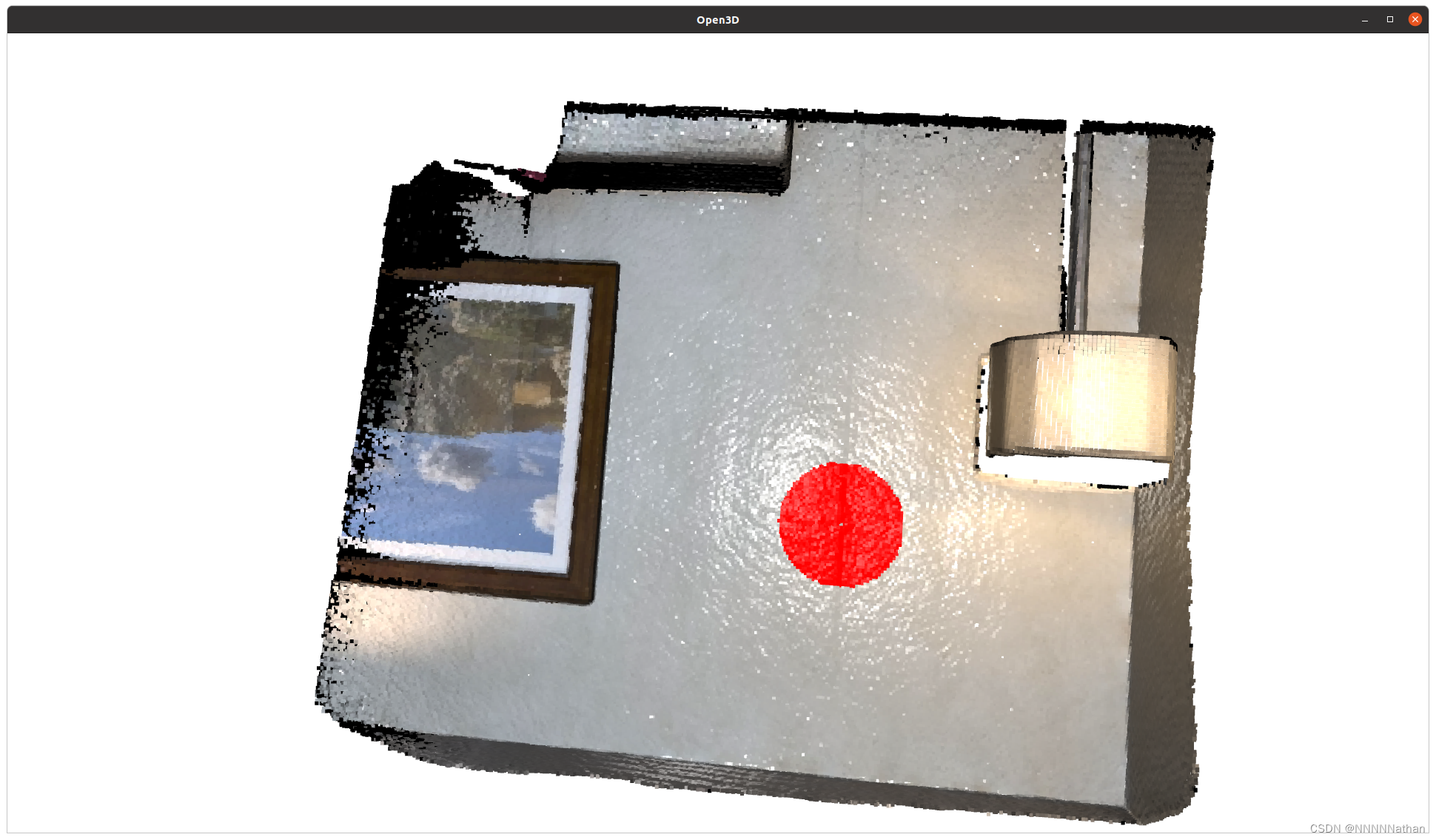
radius_search
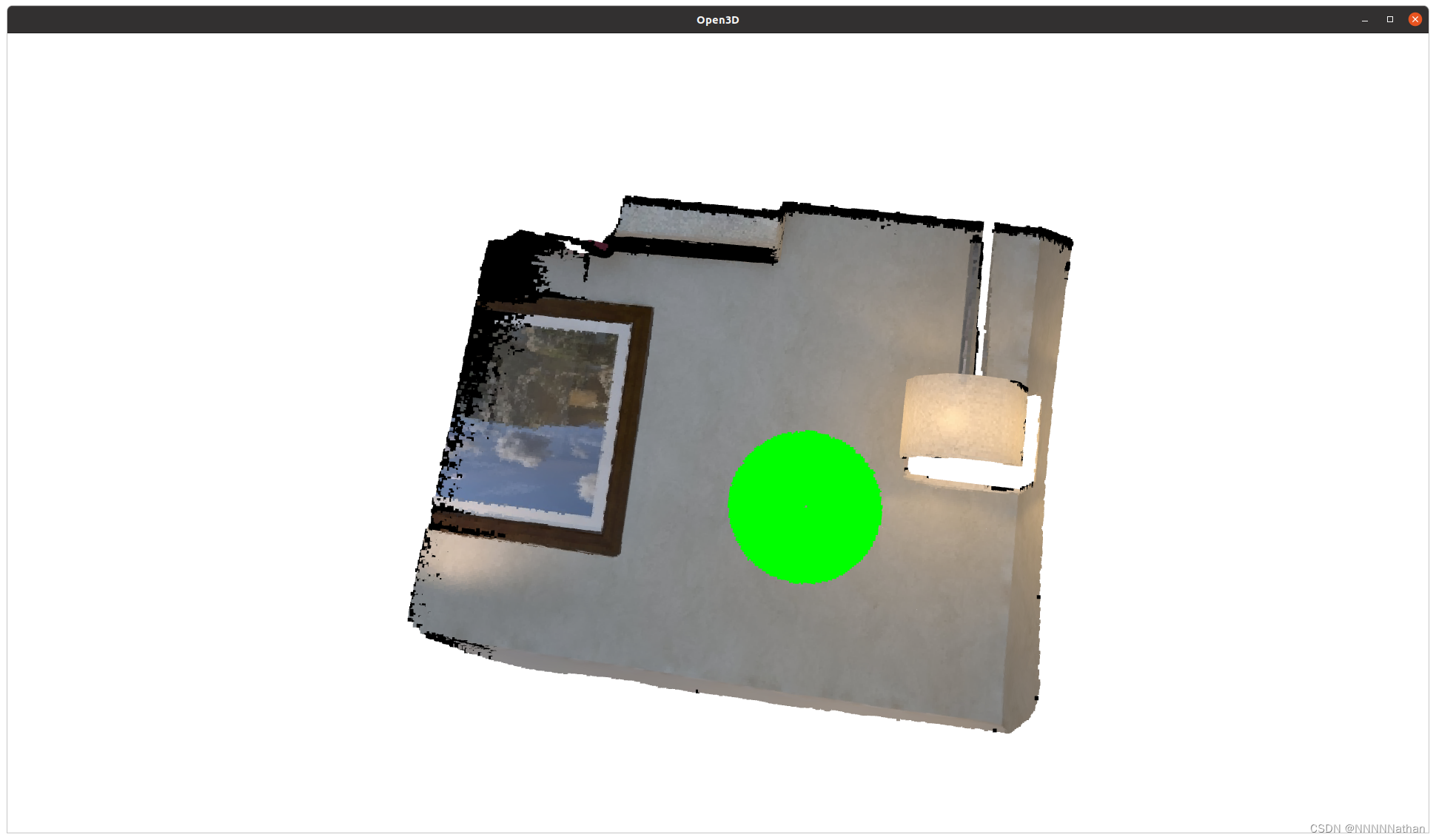
hybrid search
在open3d中除了KNN search和RNN search(radius search),还提供了一个混合的搜索模式(hybrid search);该函数返回最多返回k个距离锚搜索点小于给定半径的最近邻点,属于KNN和RNN搜索的融合搜索方式。
import numpy as np
import open3d as o3ddef hybrid_search():print("Loading pointcloud ...")sample_pcd_data = o3d.data.PCDPointCloud()pcd = o3d.io.read_point_cloud(sample_pcd_data.path)pcd_tree = o3d.geometry.KDTreeFlann(pcd)"""在选定的半径范围内,找出最近的2000个点"""[k, idx, _] = pcd_tree.search_hybrid_vector_3d(query=pcd.points[50000],radius=0.3,max_nn=2000)np.asarray(pcd.colors)[idx[1:], :] = [0, 0, 1]print("Displaying the final point cloud ...\n")o3d.visualization.draw_geometries([pcd])if __name__ == "__main__":hybrid_search()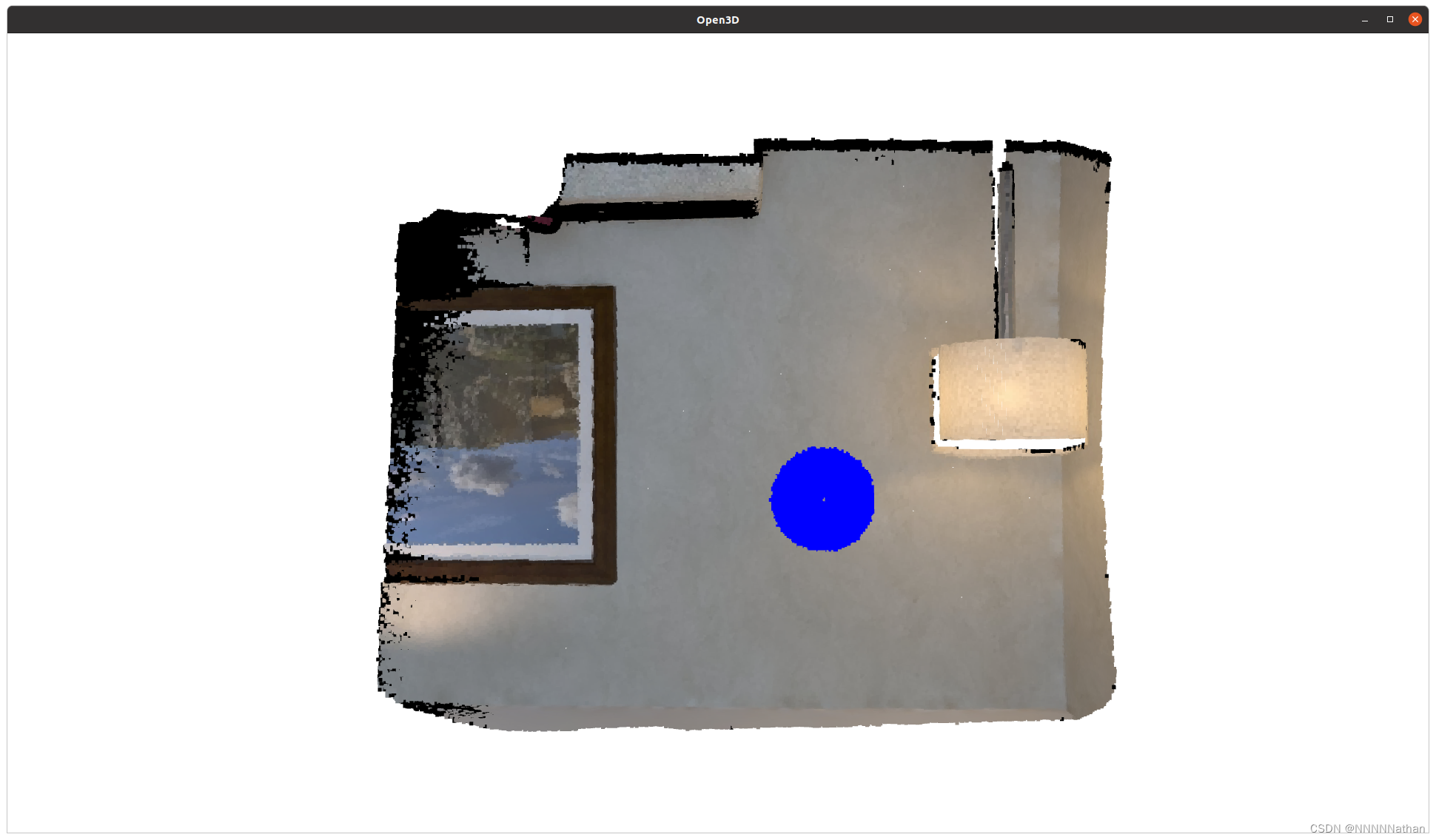
注:上述提到的所有搜索方式都包含更高维度的向量最近邻搜索,对应search_knn_vector_xd、search_radius_vector_xd、search_hybrid_vector_xd。
2 Octree
octree是一个树形结构,其每个节点都有8个孩子(为什么是8个孩子呢?可以想象一个空间的每两个面都被切开,那么这个空间会被划分成大小相同的8个小方块;且树的结构说明这个操作是可以在每个小方块迭代执行的;直到你设定的最小方块大小以达到你所需的建模最高精度);octree常用于点云的空间划分操作,octree中一个非空的叶子节点意味着该空间中包含一个或更多的点云信息。octree对于3d空间的描述非常有用且可以被用于点云邻居点的搜索。Open3D中自建了octree的几何对象,可以创建、搜索、遍历点云的octree;用户只需要定义该octree的最大深度即可。
octree例图:
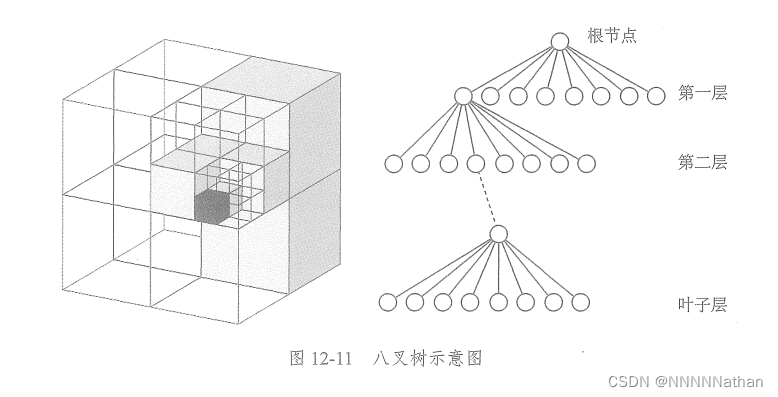
这里讲讲为什么octree相比于点云数据更加节省存储空间;在之前的点云出来中,介绍了点云的体素化,使用一个指定大小的voxel来一个空间中的所有点,该操作相当于对点云进行了下采样,使得空间中的点变少了;此处先举一个octree例子然后再进行说明,我们假定每个叶子节点的大小为1cm^3,且该octree的深度为10的话,那么该octree能建模的体积为8^10cm^3 = 1073m^3;如果假定楼层高度为4m的话,建模的面积为268.25平方米的房子; 在octree中每个节点存储的是该空间是否被占据的信息,并没有存储点的坐标,如果某个中间节点已经被占据(或为空),那么他的所有子节点都是被占据(或为空);这样就没有必要继续按此节点展开;在实际情况中由于物体是在一个空间且连在一起;空白区域也是如此;因此octree在很多时候没有必要展开到根节点就可以达到处理的目的;所以octree可以以此方式大幅节省存储空间(使用octree生成的octomap的文件大小仅为点云文件大小的1%不到)
1 从点云中创建octree
import open3d as o3d
import numpy as npimport copyimport open3d as o3dq
import numpy as npif __name__ == "__main__":N = 3000armadillo_data = o3d.data.ArmadilloMesh()pcd = o3d.io.read_triangle_mesh(armadillo_data.path).sample_points_poisson_disk(N)# Fit to unit cube.# 点云缩放到单位正方体内,center的设置保证了对象缩放时,对象的中心位置不会因为缩放而导致移动pcd.scale(1 / np.max(pcd.get_max_bound() - pcd.get_min_bound()),center=pcd.get_center())pcd.colors = o3d.utility.Vector3dVector(np.random.uniform(0, 1, size=(N, 3)))coor_mesh = o3d.geometry.TriangleMesh.create_coordinate_frame(size=1)print('Displaying input pointcloud ...')# o3d.visualization.draw_geometries([pcd])# max_depth设置了octree的深度,每个octree都是个八叉树octree = o3d.geometry.Octree(max_depth=4)pcd_for_octree = copy.deepcopy(pcd)pcd_for_octree.translate([1, 0, 0])"""param: size_expand:- A small expansion size such that the octree is slightly bigger than the original point cloud bounds to accommodate all points."""octree.convert_from_point_cloud(pcd_for_octree, size_expand=0.01)print('Displaying octree ..')o3d.visualization.draw_geometries([pcd, octree])下图中左边为点云信息,右边为octree的划分结果;可以看到在点云稀疏的地方octree的节点不会继续向下分割,有点云的地方则会继续向下分割得到更详细的结果。
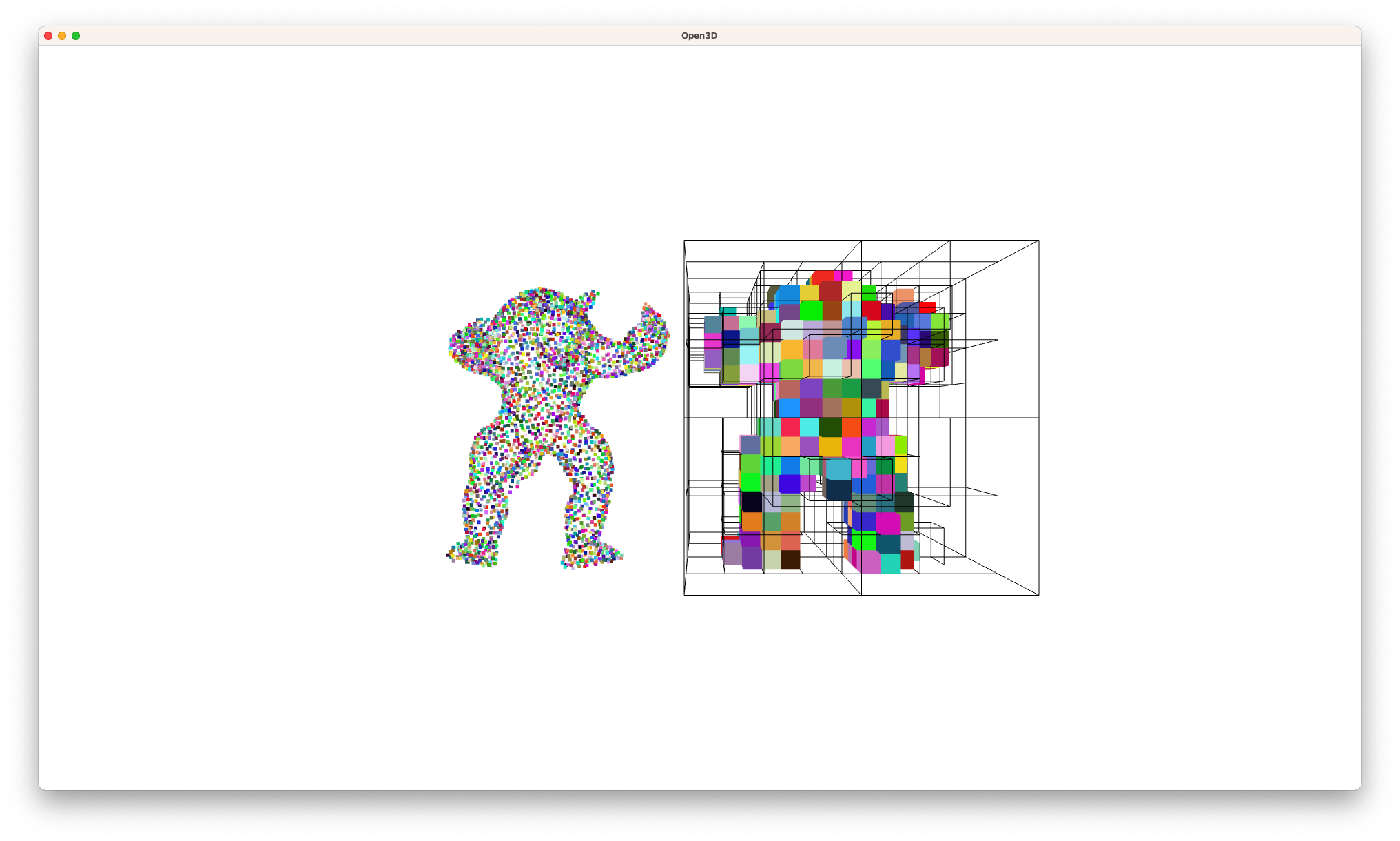
2 从voxel中创建octree
import open3d as o3d
import numpy as npif __name__ == "__main__":N = 3000armadillo_data = o3d.data.ArmadilloMesh()pcd = o3d.io.read_triangle_mesh(armadillo_data.path).sample_points_poisson_disk(N)"""Fit to unit cube.点云归一化到体积为1的立方体内center的设置保证了对象缩放时,对象的中心位置不会因为缩放而导致移动"""pcd.scale(1 / np.max(pcd.get_max_bound() - pcd.get_min_bound()),center=pcd.get_center())pcd.colors = o3d.utility.Vector3dVector(np.random.uniform(0, 1,size=(N, 3)))print('Displaying input voxel grid ...')voxel_grid = o3d.geometry.VoxelGrid.create_from_point_cloud(pcd,voxel_size=0.05)o3d.visualization.draw_geometries([voxel_grid])octree = o3d.geometry.Octree(max_depth=4)octree.create_from_voxel_grid(voxel_grid)print('Displaying octree ..')o3d.visualization.draw_geometries([octree])
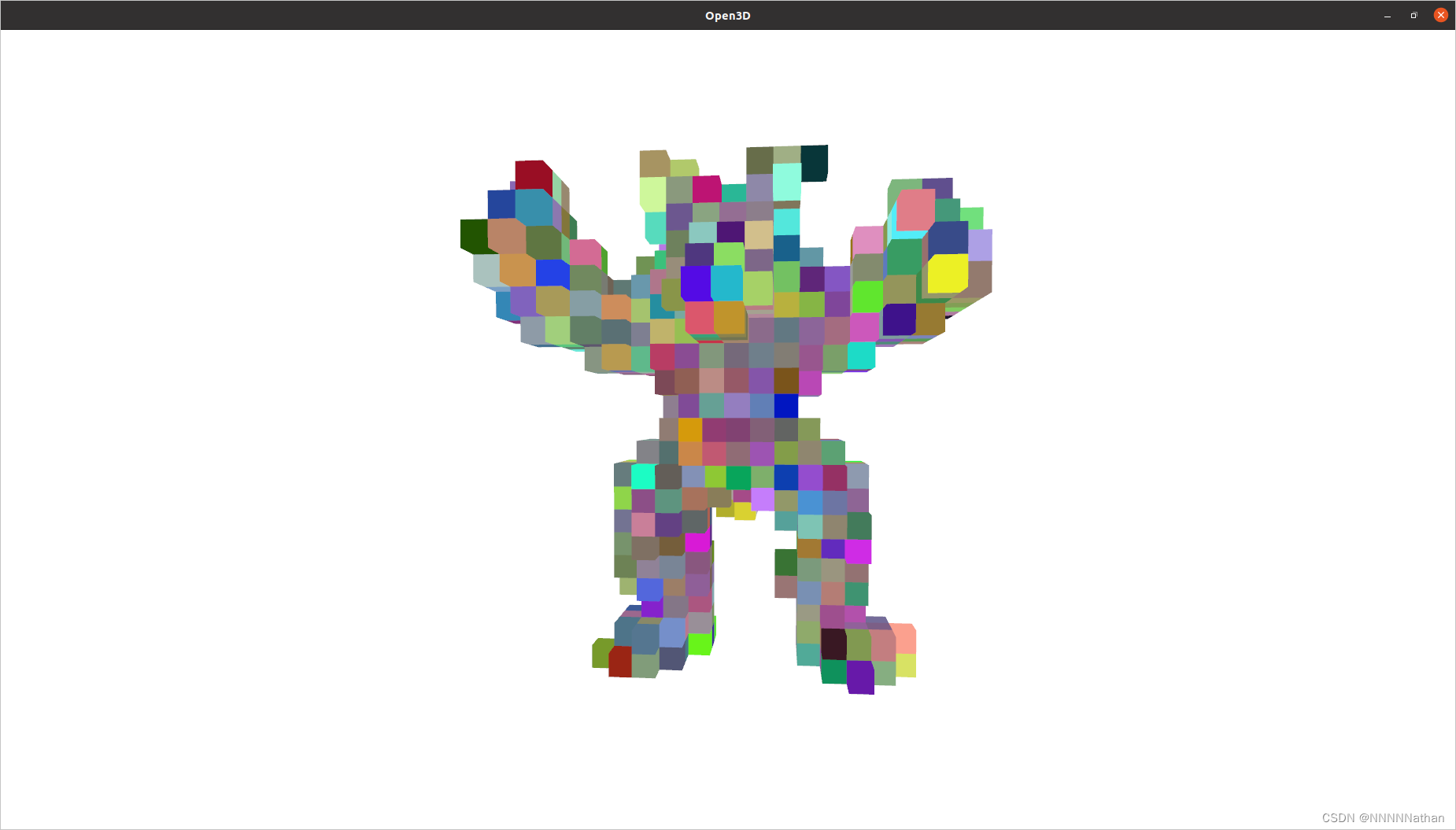
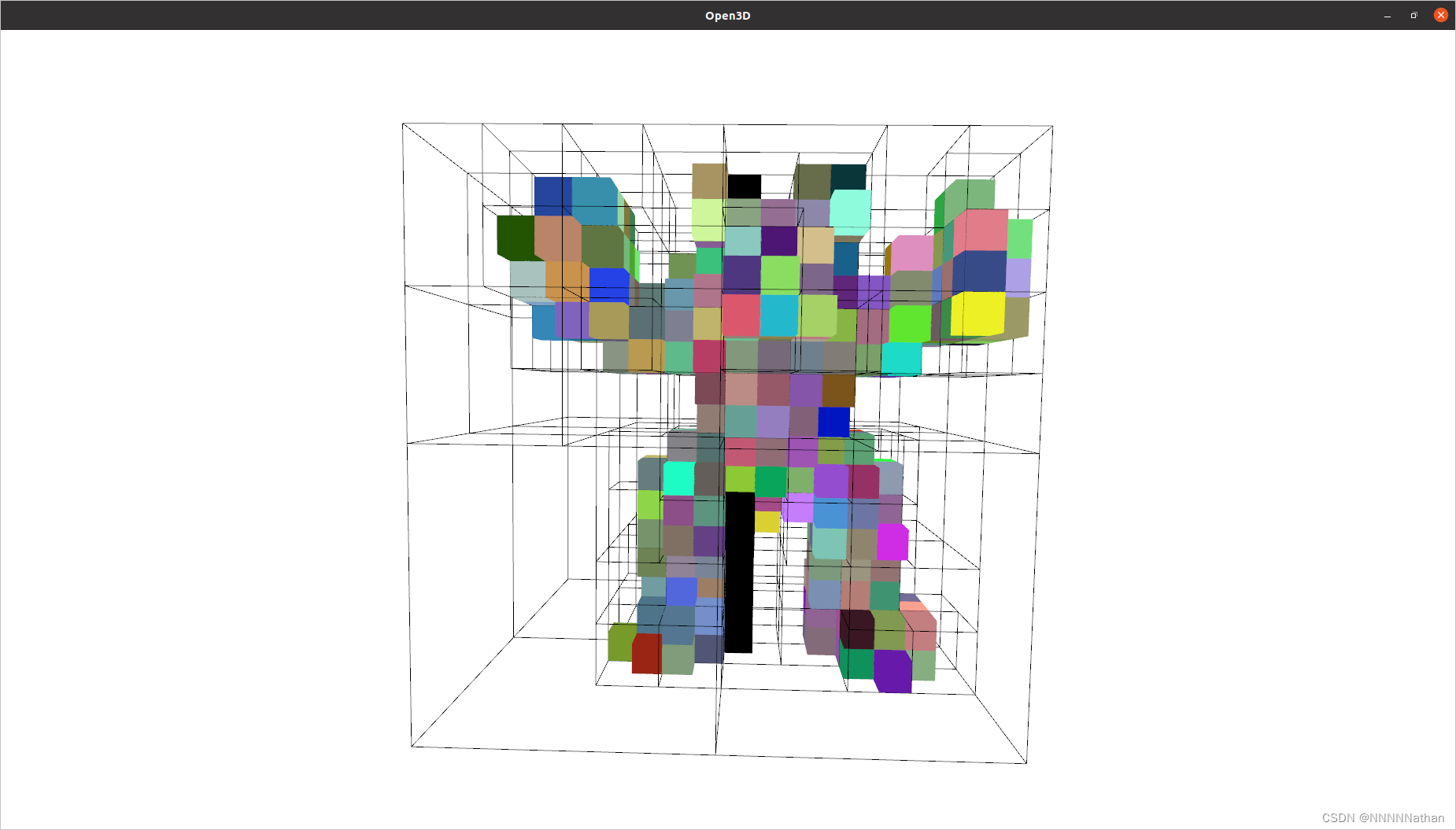
3 octree的遍历(Traversal)
在open3d中octree可以使用traverse方法来对octree进行遍历操作,该操作基于DFS(深度优先搜索)对八叉树进行搜索。traverse方法提供了回调函数,每次对一个节点(中间节点或叶子节点)进行访问以对该点进行其他操作。
下面示例中展示了使用traverse和early stoping对超过一定数量的叶子节点进行处理;其中early stopping可以高效的选取达到一定数量的节点。
4、查找点云对应的叶子节点
对octree遍历的结果如果(根据程序的设定,节点包含的子节点的点云总数量少于50则不会展开子节点继续遍历):
"""
Displaying input octree ...
Traversing octree ...
0: Internal node at depth 0 has 8 children and 3000 points ([-2.72495985 31.2744969 1.92589911])0: Internal node at depth 1 has 4 children and 94 points ([-2.72495985 31.2744969 1.92589911])4: Internal node at depth 2 has 2 children and 19 points ([-2.72495985 31.2744969 2.17839911])5: Internal node at depth 2 has 2 children and 9 points ([-2.47245985 31.2744969 2.17839911])6: Internal node at depth 2 has 1 children and 6 points ([-2.72495985 31.5269969 2.17839911])7: Internal node at depth 2 has 3 children and 60 points ([-2.47245985 31.5269969 2.17839911])4: Internal node at depth 3 has 4 children and 24 points ([-2.47245985 31.5269969 2.30464911])6: Internal node at depth 3 has 2 children and 14 points ([-2.47245985 31.6532469 2.30464911])7: Internal node at depth 3 has 4 children and 22 points ([-2.34620985 31.6532469 2.30464911])1: Internal node at depth 1 has 2 children and 68 points ([-2.21995985 31.2744969 1.92589911])4: Internal node at depth 2 has 2 children and 14 points ([-2.21995985 31.2744969 2.17839911])6: Internal node at depth 2 has 4 children and 54 points ([-2.21995985 31.5269969 2.17839911])4: Internal node at depth 3 has 1 children and 4 points ([-2.21995985 31.5269969 2.30464911])5: Internal node at depth 3 has 4 children and 19 points ([-2.09370985 31.5269969 2.30464911])6: Internal node at depth 3 has 4 children and 24 points ([-2.21995985 31.6532469 2.30464911])7: Internal node at depth 3 has 1 children and 7 points ([-2.09370985 31.6532469 2.30464911])2: Internal node at depth 1 has 8 children and 617 points ([-2.72495985 31.7794969 1.92589911])0: Internal node at depth 2 has 2 children and 11 points ([-2.72495985 31.7794969 1.92589911])1: Internal node at depth 2 has 1 children and 10 points ([-2.47245985 31.7794969 1.92589911])2: Internal node at depth 2 has 4 children and 66 points ([-2.72495985 32.0319969 1.92589911])1: Internal node at depth 3 has 1 children and 1 points ([-2.59870985 32.0319969 1.92589911])4: Internal node at depth 3 has 4 children and 25 points ([-2.72495985 32.0319969 2.05214911])5: Internal node at depth 3 has 4 children and 31 points ([-2.59870985 32.0319969 2.05214911])7: Internal node at depth 3 has 1 children and 9 points ([-2.59870985 32.1582469 2.05214911])3: Internal node at depth 2 has 1 children and 6 points ([-2.47245985 32.0319969 1.92589911])4: Internal node at depth 2 has 4 children and 90 points ([-2.72495985 31.7794969 2.17839911])2: Internal node at depth 3 has 2 children and 14 points ([-2.72495985 31.9057469 2.17839911])3: Internal node at depth 3 has 5 children and 35 points ([-2.59870985 31.9057469 2.17839911])6: Internal node at depth 3 has 1 children and 4 points ([-2.72495985 31.9057469 2.30464911])7: Internal node at depth 3 has 8 children and 37 points ([-2.59870985 31.9057469 2.30464911])5: Internal node at depth 2 has 5 children and 140 points ([-2.47245985 31.7794969 2.17839911])3: Internal node at depth 3 has 2 children and 18 points ([-2.34620985 31.9057469 2.17839911])4: Internal node at depth 3 has 1 children and 6 points ([-2.47245985 31.7794969 2.30464911])5: Internal node at depth 3 has 7 children and 38 points ([-2.34620985 31.7794969 2.30464911])6: Internal node at depth 3 has 7 children and 45 points ([-2.47245985 31.9057469 2.30464911])7: Internal node at depth 3 has 4 children and 33 points ([-2.34620985 31.9057469 2.30464911])6: Internal node at depth 2 has 4 children and 115 points ([-2.72495985 32.0319969 2.17839911])0: Internal node at depth 3 has 4 children and 28 points ([-2.72495985 32.0319969 2.17839911])1: Internal node at depth 3 has 7 children and 42 points ([-2.59870985 32.0319969 2.17839911])4: Internal node at depth 3 has 2 children and 8 points ([-2.72495985 32.0319969 2.30464911])5: Internal node at depth 3 has 6 children and 37 points ([-2.59870985 32.0319969 2.30464911])7: Internal node at depth 2 has 6 children and 179 points ([-2.47245985 32.0319969 2.17839911])1: Internal node at depth 3 has 7 children and 45 points ([-2.34620985 32.0319969 2.17839911])2: Internal node at depth 3 has 3 children and 7 points ([-2.47245985 32.1582469 2.17839911])3: Internal node at depth 3 has 7 children and 44 points ([-2.34620985 32.1582469 2.17839911])4: Internal node at depth 3 has 6 children and 31 points ([-2.47245985 32.0319969 2.30464911])5: Internal node at depth 3 has 3 children and 21 points ([-2.34620985 32.0319969 2.30464911])7: Internal node at depth 3 has 5 children and 31 points ([-2.34620985 32.1582469 2.30464911])3: Internal node at depth 1 has 7 children and 548 points ([-2.21995985 31.7794969 1.92589911])0: Internal node at depth 2 has 1 children and 6 points ([-2.21995985 31.7794969 1.92589911])2: Internal node at depth 2 has 1 children and 7 points ([-2.21995985 32.0319969 1.92589911])3: Internal node at depth 2 has 3 children and 17 points ([-1.96745985 32.0319969 1.92589911])4: Internal node at depth 2 has 5 children and 123 points ([-2.21995985 31.7794969 2.17839911])2: Internal node at depth 3 has 2 children and 14 points ([-2.21995985 31.9057469 2.17839911])4: Internal node at depth 3 has 7 children and 34 points ([-2.21995985 31.7794969 2.30464911])5: Internal node at depth 3 has 1 children and 1 points ([-2.09370985 31.7794969 2.30464911])6: Internal node at depth 3 has 5 children and 37 points ([-2.21995985 31.9057469 2.30464911])7: Internal node at depth 3 has 7 children and 37 points ([-2.09370985 31.9057469 2.30464911])5: Internal node at depth 2 has 4 children and 67 points ([-1.96745985 31.7794969 2.17839911])2: Internal node at depth 3 has 2 children and 21 points ([-1.96745985 31.9057469 2.17839911])3: Internal node at depth 3 has 1 children and 2 points ([-1.84120985 31.9057469 2.17839911])6: Internal node at depth 3 has 7 children and 40 points ([-1.96745985 31.9057469 2.30464911])7: Internal node at depth 3 has 2 children and 4 points ([-1.84120985 31.9057469 2.30464911])6: Internal node at depth 2 has 6 children and 169 points ([-2.21995985 32.0319969 2.17839911])0: Internal node at depth 3 has 6 children and 35 points ([-2.21995985 32.0319969 2.17839911])2: Internal node at depth 3 has 6 children and 43 points ([-2.21995985 32.1582469 2.17839911])3: Internal node at depth 3 has 2 children and 5 points ([-2.09370985 32.1582469 2.17839911])4: Internal node at depth 3 has 4 children and 37 points ([-2.21995985 32.0319969 2.30464911])5: Internal node at depth 3 has 4 children and 18 points ([-2.09370985 32.0319969 2.30464911])6: Internal node at depth 3 has 5 children and 31 points ([-2.21995985 32.1582469 2.30464911])7: Internal node at depth 2 has 6 children and 159 points ([-1.96745985 32.0319969 2.17839911])0: Internal node at depth 3 has 6 children and 35 points ([-1.96745985 32.0319969 2.17839911])1: Internal node at depth 3 has 4 children and 24 points ([-1.84120985 32.0319969 2.17839911])2: Internal node at depth 3 has 3 children and 30 points ([-1.96745985 32.1582469 2.17839911])3: Internal node at depth 3 has 2 children and 6 points ([-1.84120985 32.1582469 2.17839911])4: Internal node at depth 3 has 7 children and 48 points ([-1.96745985 32.0319969 2.30464911])5: Internal node at depth 3 has 3 children and 16 points ([-1.84120985 32.0319969 2.30464911])4: Internal node at depth 1 has 5 children and 515 points ([-2.72495985 31.2744969 2.43089911])0: Internal node at depth 2 has 3 children and 90 points ([-2.72495985 31.2744969 2.43089911])1: Internal node at depth 3 has 6 children and 59 points ([-2.59870985 31.2744969 2.43089911])0: Leaf node at depth 4 has 14 points with origin [-2.59870985 31.2744969 2.43089911]1: Leaf node at depth 4 has 14 points with origin [-2.53558485 31.2744969 2.43089911]3: Leaf node at depth 4 has 5 points with origin [-2.53558485 31.3376219 2.43089911]4: Leaf node at depth 4 has 4 points with origin [-2.59870985 31.2744969 2.49402411]5: Leaf node at depth 4 has 13 points with origin [-2.53558485 31.2744969 2.49402411]7: Leaf node at depth 4 has 9 points with origin [-2.53558485 31.3376219 2.49402411]3: Internal node at depth 3 has 4 children and 27 points ([-2.59870985 31.4007469 2.43089911])7: Internal node at depth 3 has 2 children and 4 points ([-2.59870985 31.4007469 2.55714911])1: Internal node at depth 2 has 4 children and 146 points ([-2.47245985 31.2744969 2.43089911])0: Internal node at depth 3 has 7 children and 45 points ([-2.47245985 31.2744969 2.43089911])2: Internal node at depth 3 has 6 children and 51 points ([-2.47245985 31.4007469 2.43089911])0: Leaf node at depth 4 has 9 points with origin [-2.47245985 31.4007469 2.43089911]1: Leaf node at depth 4 has 11 points with origin [-2.40933485 31.4007469 2.43089911]2: Leaf node at depth 4 has 3 points with origin [-2.47245985 31.4638719 2.43089911]3: Leaf node at depth 4 has 8 points with origin [-2.40933485 31.4638719 2.43089911]5: Leaf node at depth 4 has 9 points with origin [-2.40933485 31.4007469 2.49402411]7: Leaf node at depth 4 has 11 points with origin [-2.40933485 31.4638719 2.49402411]4: Internal node at depth 3 has 4 children and 31 points ([-2.47245985 31.2744969 2.55714911])6: Internal node at depth 3 has 4 children and 19 points ([-2.47245985 31.4007469 2.55714911])2: Internal node at depth 2 has 2 children and 29 points ([-2.72495985 31.5269969 2.43089911])3: Internal node at depth 2 has 8 children and 216 points ([-2.47245985 31.5269969 2.43089911])0: Internal node at depth 3 has 7 children and 38 points ([-2.47245985 31.5269969 2.43089911])1: Internal node at depth 3 has 4 children and 18 points ([-2.34620985 31.5269969 2.43089911])2: Internal node at depth 3 has 7 children and 39 points ([-2.47245985 31.6532469 2.43089911])3: Internal node at depth 3 has 5 children and 24 points ([-2.34620985 31.6532469 2.43089911])4: Internal node at depth 3 has 3 children and 12 points ([-2.47245985 31.5269969 2.55714911])5: Internal node at depth 3 has 3 children and 15 points ([-2.34620985 31.5269969 2.55714911])6: Internal node at depth 3 has 4 children and 26 points ([-2.47245985 31.6532469 2.55714911])7: Internal node at depth 3 has 7 children and 44 points ([-2.34620985 31.6532469 2.55714911])7: Internal node at depth 2 has 1 children and 34 points ([-2.47245985 31.5269969 2.68339911])5: Internal node at depth 1 has 4 children and 476 points ([-2.21995985 31.2744969 2.43089911])0: Internal node at depth 2 has 8 children and 254 points ([-2.21995985 31.2744969 2.43089911])0: Internal node at depth 3 has 3 children and 21 points ([-2.21995985 31.2744969 2.43089911])1: Internal node at depth 3 has 7 children and 64 points ([-2.09370985 31.2744969 2.43089911])0: Leaf node at depth 4 has 14 points with origin [-2.09370985 31.2744969 2.43089911]1: Leaf node at depth 4 has 17 points with origin [-2.03058485 31.2744969 2.43089911]2: Leaf node at depth 4 has 1 points with origin [-2.09370985 31.3376219 2.43089911]4: Leaf node at depth 4 has 6 points with origin [-2.09370985 31.2744969 2.49402411]5: Leaf node at depth 4 has 15 points with origin [-2.03058485 31.2744969 2.49402411]6: Leaf node at depth 4 has 10 points with origin [-2.09370985 31.3376219 2.49402411]7: Leaf node at depth 4 has 1 points with origin [-2.03058485 31.3376219 2.49402411]2: Internal node at depth 3 has 4 children and 25 points ([-2.21995985 31.4007469 2.43089911])3: Internal node at depth 3 has 8 children and 44 points ([-2.09370985 31.4007469 2.43089911])4: Internal node at depth 3 has 3 children and 25 points ([-2.21995985 31.2744969 2.55714911])5: Internal node at depth 3 has 6 children and 32 points ([-2.09370985 31.2744969 2.55714911])6: Internal node at depth 3 has 2 children and 18 points ([-2.21995985 31.4007469 2.55714911])7: Internal node at depth 3 has 4 children and 25 points ([-2.09370985 31.4007469 2.55714911])1: Internal node at depth 2 has 1 children and 3 points ([-1.96745985 31.2744969 2.43089911])2: Internal node at depth 2 has 8 children and 216 points ([-2.21995985 31.5269969 2.43089911])0: Internal node at depth 3 has 6 children and 43 points ([-2.21995985 31.5269969 2.43089911])1: Internal node at depth 3 has 6 children and 41 points ([-2.09370985 31.5269969 2.43089911])2: Internal node at depth 3 has 5 children and 22 points ([-2.21995985 31.6532469 2.43089911])3: Internal node at depth 3 has 7 children and 42 points ([-2.09370985 31.6532469 2.43089911])4: Internal node at depth 3 has 3 children and 10 points ([-2.21995985 31.5269969 2.55714911])5: Internal node at depth 3 has 2 children and 9 points ([-2.09370985 31.5269969 2.55714911])6: Internal node at depth 3 has 6 children and 39 points ([-2.21995985 31.6532469 2.55714911])7: Internal node at depth 3 has 2 children and 10 points ([-2.09370985 31.6532469 2.55714911])6: Internal node at depth 2 has 1 children and 3 points ([-2.21995985 31.5269969 2.68339911])6: Internal node at depth 1 has 6 children and 350 points ([-2.72495985 31.7794969 2.43089911])0: Internal node at depth 2 has 1 children and 11 points ([-2.72495985 31.7794969 2.43089911])1: Internal node at depth 2 has 7 children and 175 points ([-2.47245985 31.7794969 2.43089911])0: Internal node at depth 3 has 4 children and 30 points ([-2.47245985 31.7794969 2.43089911])1: Internal node at depth 3 has 2 children and 5 points ([-2.34620985 31.7794969 2.43089911])2: Internal node at depth 3 has 6 children and 37 points ([-2.47245985 31.9057469 2.43089911])4: Internal node at depth 3 has 2 children and 8 points ([-2.47245985 31.7794969 2.55714911])5: Internal node at depth 3 has 6 children and 38 points ([-2.34620985 31.7794969 2.55714911])6: Internal node at depth 3 has 5 children and 26 points ([-2.47245985 31.9057469 2.55714911])7: Internal node at depth 3 has 4 children and 31 points ([-2.34620985 31.9057469 2.55714911])2: Internal node at depth 2 has 1 children and 3 points ([-2.72495985 32.0319969 2.43089911])3: Internal node at depth 2 has 6 children and 156 points ([-2.47245985 32.0319969 2.43089911])0: Internal node at depth 3 has 6 children and 40 points ([-2.47245985 32.0319969 2.43089911])2: Internal node at depth 3 has 2 children and 2 points ([-2.47245985 32.1582469 2.43089911])3: Internal node at depth 3 has 5 children and 38 points ([-2.34620985 32.1582469 2.43089911])4: Internal node at depth 3 has 4 children and 23 points ([-2.47245985 32.0319969 2.55714911])5: Internal node at depth 3 has 5 children and 33 points ([-2.34620985 32.0319969 2.55714911])7: Internal node at depth 3 has 4 children and 20 points ([-2.34620985 32.1582469 2.55714911])5: Internal node at depth 2 has 1 children and 3 points ([-2.47245985 31.7794969 2.68339911])7: Internal node at depth 2 has 1 children and 2 points ([-2.47245985 32.0319969 2.68339911])7: Internal node at depth 1 has 6 children and 332 points ([-2.21995985 31.7794969 2.43089911])0: Internal node at depth 2 has 7 children and 173 points ([-2.21995985 31.7794969 2.43089911])0: Internal node at depth 3 has 4 children and 27 points ([-2.21995985 31.7794969 2.43089911])1: Internal node at depth 3 has 3 children and 10 points ([-2.09370985 31.7794969 2.43089911])3: Internal node at depth 3 has 7 children and 42 points ([-2.09370985 31.9057469 2.43089911])4: Internal node at depth 3 has 7 children and 40 points ([-2.21995985 31.7794969 2.55714911])5: Internal node at depth 3 has 1 children and 3 points ([-2.09370985 31.7794969 2.55714911])6: Internal node at depth 3 has 5 children and 35 points ([-2.21995985 31.9057469 2.55714911])7: Internal node at depth 3 has 3 children and 16 points ([-2.09370985 31.9057469 2.55714911])1: Internal node at depth 2 has 1 children and 13 points ([-1.96745985 31.7794969 2.43089911])2: Internal node at depth 2 has 6 children and 142 points ([-2.21995985 32.0319969 2.43089911])0: Internal node at depth 3 has 2 children and 4 points ([-2.21995985 32.0319969 2.43089911])1: Internal node at depth 3 has 6 children and 41 points ([-2.09370985 32.0319969 2.43089911])2: Internal node at depth 3 has 6 children and 33 points ([-2.21995985 32.1582469 2.43089911])4: Internal node at depth 3 has 6 children and 37 points ([-2.21995985 32.0319969 2.55714911])5: Internal node at depth 3 has 3 children and 12 points ([-2.09370985 32.0319969 2.55714911])6: Internal node at depth 3 has 4 children and 15 points ([-2.21995985 32.1582469 2.55714911])3: Internal node at depth 2 has 1 children and 2 points ([-1.96745985 32.0319969 2.43089911])4: Internal node at depth 2 has 1 children and 1 points ([-2.21995985 31.7794969 2.68339911])6: Internal node at depth 2 has 1 children and 1 points ([-2.21995985 32.0319969 2.68339911])Process finished with exit code 0"""4、查找点云对应的叶子节点
使用上面的traversal遍历,通过方法locate_leaf_node,可以快速定位某个点云在octree的哪个叶子节点中。
import open3d as o3d
import numpy as npif __name__ == "__main__":N = 3000armadillo_data = o3d.data.ArmadilloMesh()pcd = o3d.io.read_triangle_mesh(armadillo_data.path).sample_points_poisson_disk(N)# Fit to unit cube.pcd.scale(1 / np.max(pcd.get_max_bound() - pcd.get_min_bound()),center=pcd.get_center())pcd.colors = o3d.utility.Vector3dVector(np.random.uniform(0, 1,size=(N, 3)))octree = o3d.geometry.Octree(max_depth=4)octree.convert_from_point_cloud(pcd, size_expand=0.01)print('Displaying input octree ...')o3d.visualization.draw_geometries([octree])"""Returns leaf OctreeNode and OctreeNodeInfo where the querypoint should reside.返回查询点对应的Tuple[open3d.geometry.OctreeLeafNode, open3d.geometry.OctreeNodeInfo]"""print('Finding leaf node containing the first point of pointcloud ...')print(octree.locate_leaf_node(pcd.points[0]))"""结果:Finding leaf node containing the first point of pointcloud ...(OctreePointColorLeafNode with color [0.152902, 0.134164, 0.525544] containing 8 points., OctreeNodeInfo with origin [-2.42852, 31.9983, 2.75556], size 0.063125, depth 4, child_index 7)"""
3、KDTree的原理介绍可以参考如下文章:
欧式聚类(KD-Tree)详解,保姆级教程 - 知乎参考了 欧式聚类详解(点云数据处理)_JAT0929的博客-CSDN博客_欧式聚类欧式聚类是一种基于欧氏距离度量的聚类算法。基于KD-Tree的近邻查询算法是加速欧式聚类算法的重要预处理方法。(不想看KD-Tree的可以直接跳… https://zhuanlan.zhihu.com/p/402555908
https://zhuanlan.zhihu.com/p/402555908
